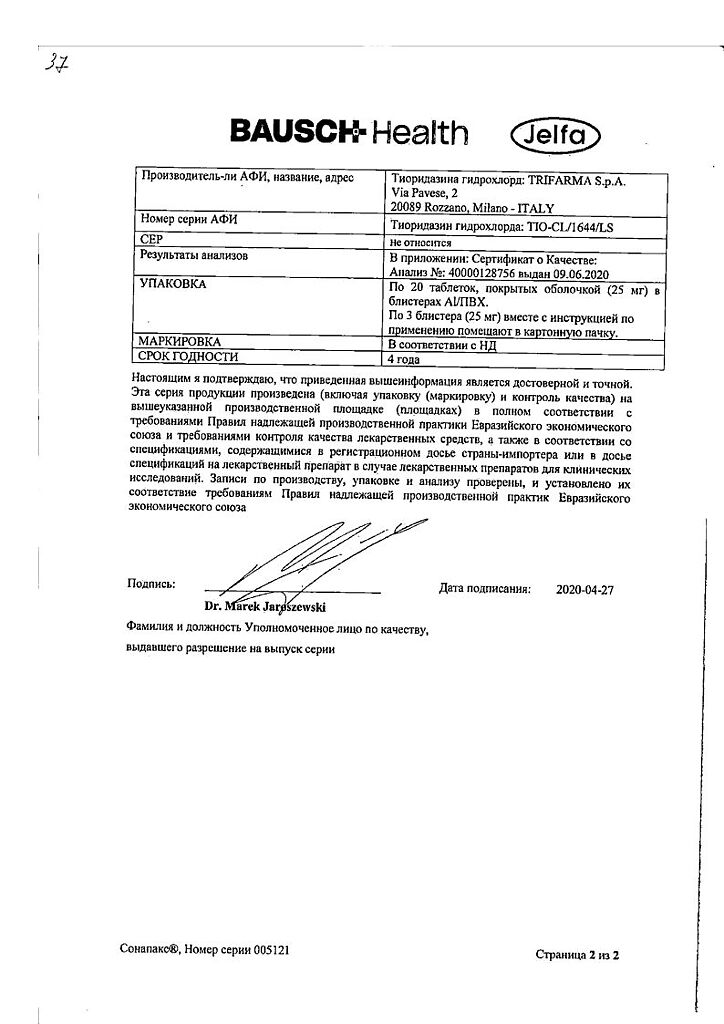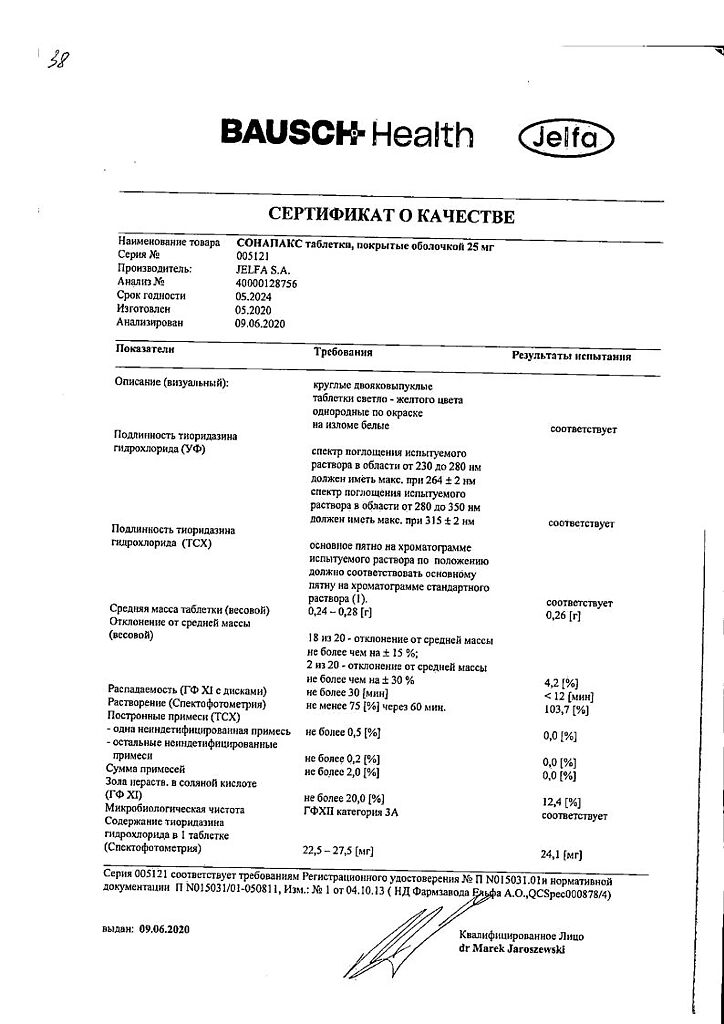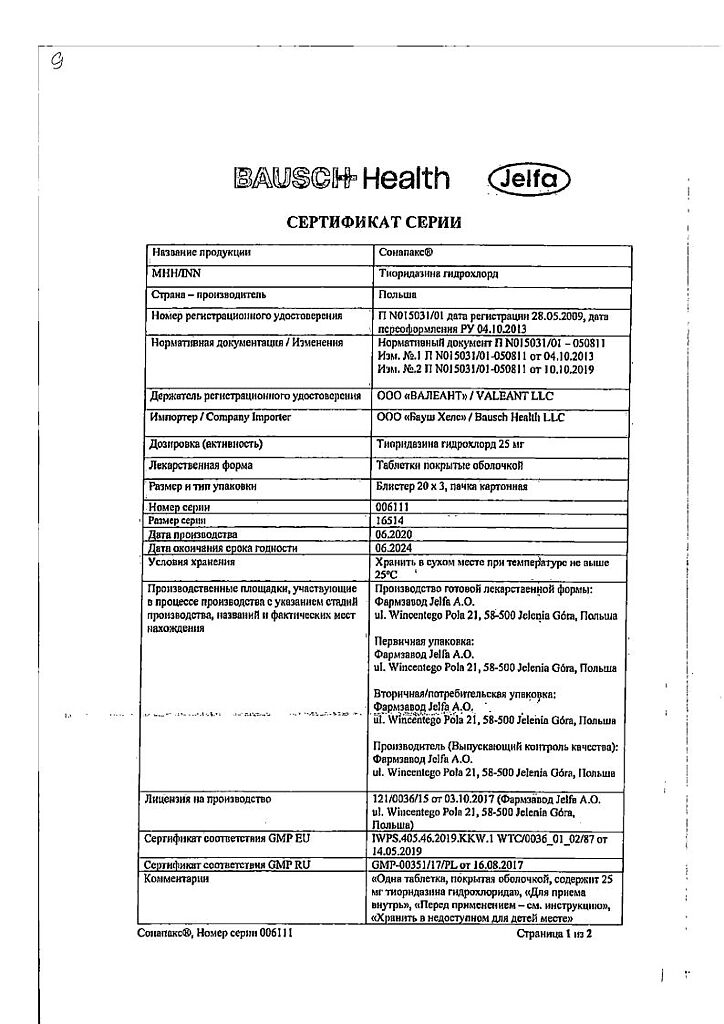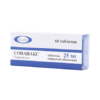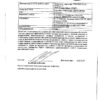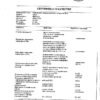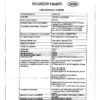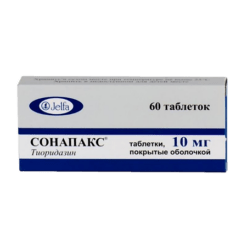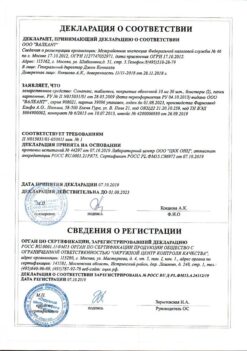No products in the cart.
Sonapax, 25 mg 60 pcs
€14.72 €12.27
Out of stock
(E-mail when Stock is available)
Description
Sonapax is neuroleptic.
Inhibits dopamine and adrenergic transmission at the level of the reticular formation of the trunk (mainly) and the cerebral cortex.
It has antipsychotic (observed after 10-14 days of use) and mild antidepressant effects.
Blocks H1-antihistamine and peripheral m-cholinoreceptors.
It has the most pronounced antihistamine and anticholinergic effects of all the drugs of the neuroleptic group.
Indications
Indications
Schizophrenia, incl. paranoid, schizoaffective disorders; psychosis, incl. involutional; psychosomatic disorders; depressive states accompanied by a feeling of fear; withdrawal syndrome in chronic alcoholism, itching (severe, painful) in skin diseases, behavioral disorders (increased psychomotor activity) in children.
Pharmacological effect
Pharmacological effect
Sonapax is a neuroleptic.
Inhibits dopamine and adrenergic transmission at the level of the reticular formation of the brainstem (mainly) and the cerebral cortex.
It has antipsychotic (noted after 10–14 days of administration) and weak antidepressant effects.
Blocks H1-antihistamine and peripheral m-cholinergic receptors.
It has the most pronounced antihistamine and anticholinergic effect among all drugs from the group of antipsychotics.
Special instructions
Special instructions
During the treatment period, it is necessary to monitor the morphological composition of the blood: refrain from drinking ethanol and engaging in potentially hazardous activities that require increased concentration and speed of psychomotor reactions.
Impact on the ability to drive vehicles and maintain machinery in motion:
Sonapax weakens motor coordination and reduces reaction, especially at the beginning of treatment, so during treatment with the drug you should refrain from driving vehicles and servicing moving mechanisms.
Active ingredient
Active ingredient
Thioridazine
Composition
Composition
1 tablet contains:
Contraindications
Contraindications
Hypersensitivity (including to phenothiazine derivatives), depression (acute condition), coma, pheochromocytoma, porphyria, hematopoietic failure, first trimester and last week of pregnancy, children under 4 years of age.
Side Effects
Side Effects
From the nervous system and sensory organs: parkinsonism syndrome, dyskinesia, akathisia, drowsiness, apathy, irritability, depression, delirium, convulsive attacks, thermoregulation disorders.
From the cardiovascular system and blood (hematopoiesis, hemostasis): tachycardia, orthostatic hypotension, agranulocytosis, leukopenia, eosinophilia, pancytopenia, thrombocytopenic purpura.
From the gastrointestinal tract: constipation, cholestatic jaundice.
From the skin: allergic reactions, discoid lupus, photosensitivity.
Other: hyper- or hypoglycemia, gynecomastia, menstrual irregularities, decreased libido.
Interaction
Interaction
Synergism of action with general anesthetics, opiates, barbiturates, ethanol, atropine.
Strengthens the hepatotoxic effect of antidiabetic drugs.
With amphetamine – has an antagonistic effect. With levodopa – reduces antiparkinsonian effect.
Use with adrenaline can lead to a sudden and pronounced decrease in blood pressure.
With guanethidine, it reduces the antihypertensive effect of the latter, but enhances the effect of other antihypertensive drugs, which increases the risk of significant orthostatic hypotension.
Reduces the effect of anticoagulants. The effect of Sonapax can be weakened by anticonvulsants, cimetidine.
Quinidine – potentiates the cardiodepressive effect.
Ephedrine – promotes a paradoxical decrease in blood pressure. Sympathomimetics – enhance arrhythmogenic effects.
Probucol, astemizole, cisapride, disopyramide, erythromycin, pimozide, procainamide and quinidine further prolong the QT interval, which increases the risk of developing ventricular tachycardia.
Antithyroid drugs increase the risk of developing agranulocytosis.
Reduces the effect of appetite suppressants (with the exception of fenfluramine).
Reduces the effectiveness of the emetic effect of apomorphine, enhances its inhibitory effect on the central nervous system.
Increases plasma concentrations of prolactin and interferes with the action of bromocriptine.
When used together with tricyclic antidepressants, maprotiline, MAO inhibitors, antihistamines, the sedative and anticholinergic effects may be prolonged and enhanced.
With thiazide diuretics – increased hyponatremia.
With lithium preparations – decreased absorption in the gastrointestinal tract, increased rate of excretion of lithium ions by the kidneys, increased severity of extrapyramidal disorders, early signs of lithium intoxication (nausea and vomiting) can be masked by the antiemetic effect of perphenazine.
When combined with beta-blockers, it enhances the hypotensive effect, increasing the risk of developing irreversible retinopathy, arrhythmias and tardive dyskinesia.
Overdose
Overdose
Symptoms: drowsiness, confusion, urinary retention, disorientation, coma, areflexia, hyperreflexia, dry mouth, nasal congestion, postural hypotension, depression of the respiratory center, convulsions, hypothermia.
Treatment is symptomatic, aimed at reducing absorption and accelerating elimination of the drug. Gastric lavage with activated carbon solution, laxatives (for example, magnesium sulfate).
Administration of isotonic solutions. Monitoring the function of the cardiovascular and respiratory systems. If necessary, artificial ventilation of the lungs, monitoring of the function of the cardiovascular system, and prevention of the development of metabolic acidosis are consistently carried out. There is no specific antidote
Storage conditions
Storage conditions
In a dry place, at a temperature not exceeding 25 °C
Shelf life
Shelf life
4 years
Manufacturer
Manufacturer
Pharmaceutical plant Elfa A.O., Poland
Additional information
| Shelf life | 4 years |
|---|---|
| Conditions of storage | In a dry place, at a temperature not exceeding 25 °C |
| Manufacturer | Jelfa Pharmzavod, Poland |
| Medication form | pills |
| Brand | Jelfa Pharmzavod |
Other forms…
Related products
Buy Sonapax, 25 mg 60 pcs with delivery to USA, UK, Europe and over 120 other countries.


